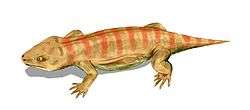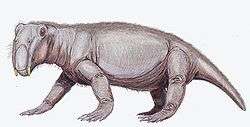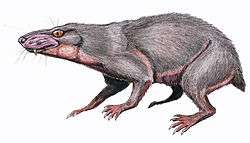Induan
| System/ Period |
Series/ Epoch |
Stage/ Age |
Age (Ma) | |
|---|---|---|---|---|
| Jurassic | Lower/ Early |
Hettangian | younger | |
| Triassic | Upper/ Late |
Rhaetian | 201.3–208.5 | |
| Norian | 208.5–~228 | |||
| Carnian | ~228–~235 | |||
| Mid/ Middle |
Ladinian | ~235–~242 | ||
| Anisian | ~242–247.2 | |||
| Lower/ Early |
Olenekian | 247.2–251.2 | ||
| Induan | 251.2–252.2 | |||
| Permian | Lopingian | Changhsingian | older | |
| Subdivision of the Triassic system according to the IUGS, as of July 2012. | ||||
The Induan is, in the geologic timescale, the first age of the Early Triassic epoch or the lowest stage of the Lower Triassic series. It spans the time between 252.17 Ma and 251.2 Ma (million years ago).[1] It is preceded by the Changhsingian and is followed by the Olenekian.
The Induan is roughly coeval with the regional Feixianguanian stage of China.
Stratigraphic definitions
The Induan stage was introduced into scientific literature by Russian stratigraphers in 1956,[2] who divided the Skythian stage that was used by Western stratigraphers into the Induan and Olenekian stages. The Russian subdivision of the Lower Triassic then slowly replaced the one used in the West.
The base of the Induan stage (which is also the base of the Lower Triassic series, the base of the Triassic system and the base of the Mesozoic erathem) is defined as the place in the fossil record where the conodont species Hindeodus parvus first appears, or at the end of the negative δ18O anomaly after the big extinction event at the Permian-Triassic boundary. The global reference profile of the base of the Induan is situated in Changxing County, China.[3]
The top of the Induan stage (the base of the Olenekian) is at the first appearance of ammonite species Meekoceras gracilitatis.
Though the Induan is an unusually short age at this point in the geologic timescale, its million years' extent still contains five ammonite biozones in the boreal domain and four ammonite biozones in the Tethyan domain.
Palaeontology
The Induan age followed the mass extinction event at the end of the Permian period. Both global biodiversity and community-level (alpha) diversity remained low through much of this stage of the Triassic.[4] Much of the world remained almost lifeless, deserted, hot, and dry. The lystrosaurids (below) and the proterosuchids (below) were the only groups of land animals to dominate during the Induan stage. Other animals, such as the ammonites, fishes, insects, and the tetrapods (cynodonts, amphibians, reptiles, etc.) remained rare and terrestrial ecosystems did not recover for some 30 million years.[4] Both the seas and much of the freshwater during the Induan were anoxic.
Archosauromorphs
| Archosauromorphs of the Induan | ||||
|---|---|---|---|---|
| Taxa | Presence | Location | Description | Images |
| South Africa | The largest land reptile during the Early Triassic period, equivalent in size to today's Komodo Dragons. It looked somewhat similar to a primitive crocodile, and shared many of their modern features like long jaws, powerful neck muscles, short legs and a lengthy tail, while retaining several of its own unique features such as its long legs, and hooked shaped mouth. | | ||
| South Africa, Fremouw Formation, Antarctica | ||||
†Conodonts
| †Conodonts of the Induan | ||||
|---|---|---|---|---|
| Taxa | Presence | Location | Description | Images |
| China | ||||
Procolophonomorphs
| Procolophonomorpha of the Induan | ||||
|---|---|---|---|---|
| Taxa | Presence | Location | Description | Images |
| Late Permian to Late Triassic | South Africa | A genus of lizard-shaped reptiles |
| |
Temnospondyls
| Temnospondyli of the Induan | ||||
|---|---|---|---|---|
| Taxa | Presence | Location | Description | Images |
| Northern Russia | | |||
Therapsids
| Therapsids of the Induan | ||||
|---|---|---|---|---|
| Taxa | Presence | Location | Description | Images |
|
| ||||
| Late Permian to Early Triassic | Antarctica, Russia, India and South Africa | The most common group of terrestrial vertebrates during the Early Triassic: for a while 95% of land vertebrates were Lystrosaurus | ||
| Late Permian to Early Triassic | South Africa | |||
| A therocephalian | ||||
| Early Triassic | South Africa, Antarctica | A cat-sized cynodont. Many scientists suggest that the pits on the skull indicate that Thrinaxodon had whiskers and, therefore, probably had a covering of fur. There are suggestions that it was warm-blooded. Even so, it still laid eggs. | ||
References
- ↑ According to Gradstein et al. (2004). Brack et al. (2005) give 252.6 to 251.0 Ma
- ↑ Kiparisova & Popov (1956)
- ↑ Yin Hongfu, Zhang Kexin, Tong Jinnan, Yang Zunyi und Wu Shunbao: '"The Global Stratotype Section and Point (GSSP)of the Permian-Triassic Boundary." Episodes, 24(2): 102-114, Beijing 2001 ISSN 0705-3797.
- 1 2 Sahney, S.; Benton, M.J. (2008). "Recovery from the most profound mass extinction of all time" (PDF). Proceedings of the Royal Society: Biological. 275 (1636): 759–65. doi:10.1098/rspb.2007.1370. PMC 2596898
 . PMID 18198148.
. PMID 18198148.
Sources
- Brack, P.; Rieber, H.; Nicora, A. & Mundil, R.; 2005: The Global boundary Stratotype Section and Point (GSSP) of the Ladinian Stage (Middle Triassic) at Bagolino (Southern Alps, Northern Italy) and its implications for the Triassic time scale, Episodes 28(4), pp. 233–244.
- Gradstein, F. M.; Ogg, J. G. & Smith, A. G.; 2004: A Geologic Time Scale 2004, Cambridge University Press.
- Kiparisova, Lubov Dmitrievna & Popov, Yurij Nikolaivitch; 1956: Расчленение нижнего отдела триасовой системы на ярусы (Subdivision of the lower series of the Triassic System into stages), Doklady Akademii Nauk SSSR 109(4), pp 842–845 (Russian).
External links
- GeoWhen Database - Induan
- Lower Triassic timescale at the website of the subcommission for stratigraphic information of the ICS
- Lower Triassic timescale at the website of Norges Network of offshore records of geology and stratigraphy.
| Triassic Period | ||
|---|---|---|
| Lower/Early Triassic | Middle Triassic | Upper/Late Triassic |
| Induan |Olenekian | Anisian | Ladinian | Carnian | Norian Rhaetian |
Coordinates: 31°04′47″N 119°42′21″E / 31.0797°N 119.7058°E








